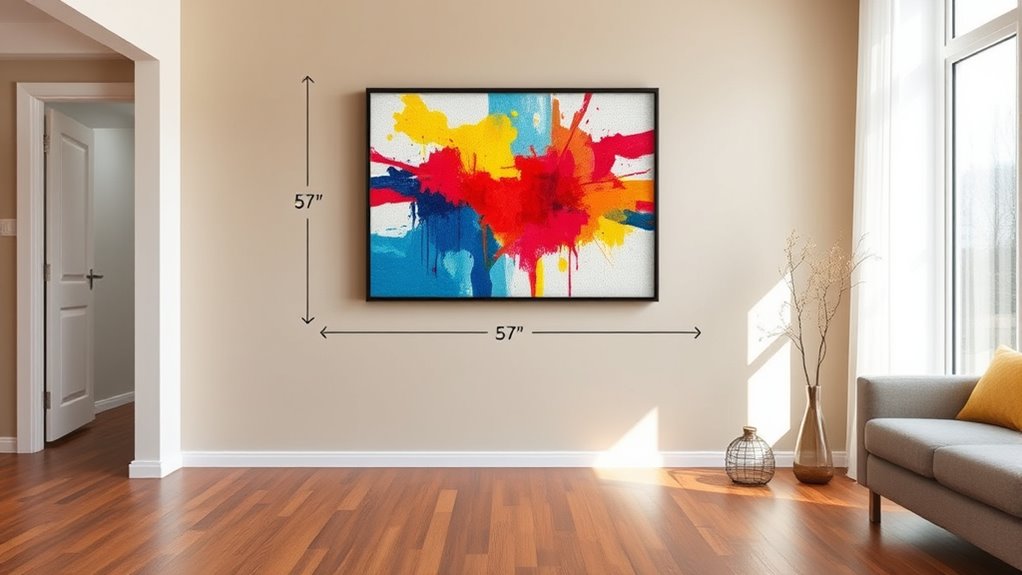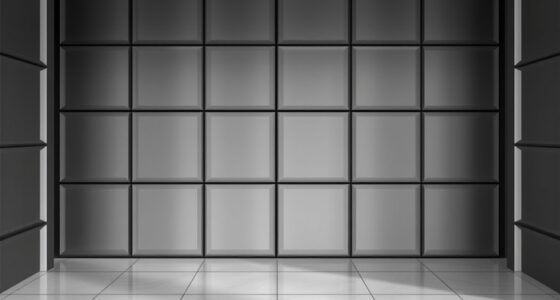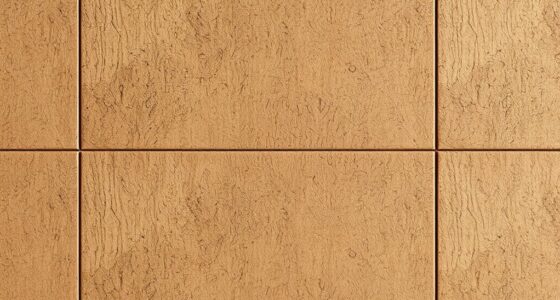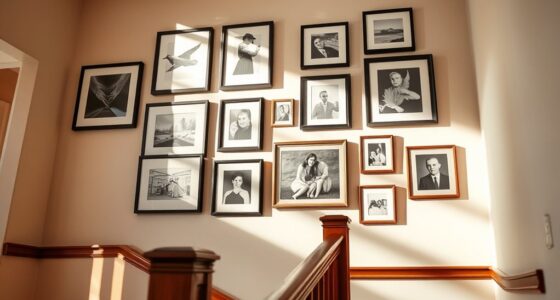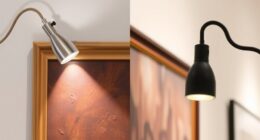The 57-inch rule suggests hanging art so the center is approximately at your eye level, around 57 inches from the floor, making it feel balanced and natural. This guideline works well for most spaces because it aligns with the average eye height and room proportions. To get it just right, measure from the floor and consider your artwork’s size and furniture placement. If you’d like tips on customizing this rule for your space, keep exploring.
Key Takeaways
- The 57-inch rule suggests hanging art so its center is approximately 57 inches from the floor, aligning with average eye level.
- This height creates a balanced, comfortable viewing experience and works well with most ceiling heights and room sizes.
- Measure from the floor to your eye level (about 57 inches) to accurately position artwork at the ideal height.
- Adjust the hanging height based on artwork size, furniture placement, and room proportions for optimal aesthetic harmony.
- Consider room features and wall space; the 57-inch guideline provides a reliable starting point for cohesive art display.
The Origins of the 57-Inch Guideline
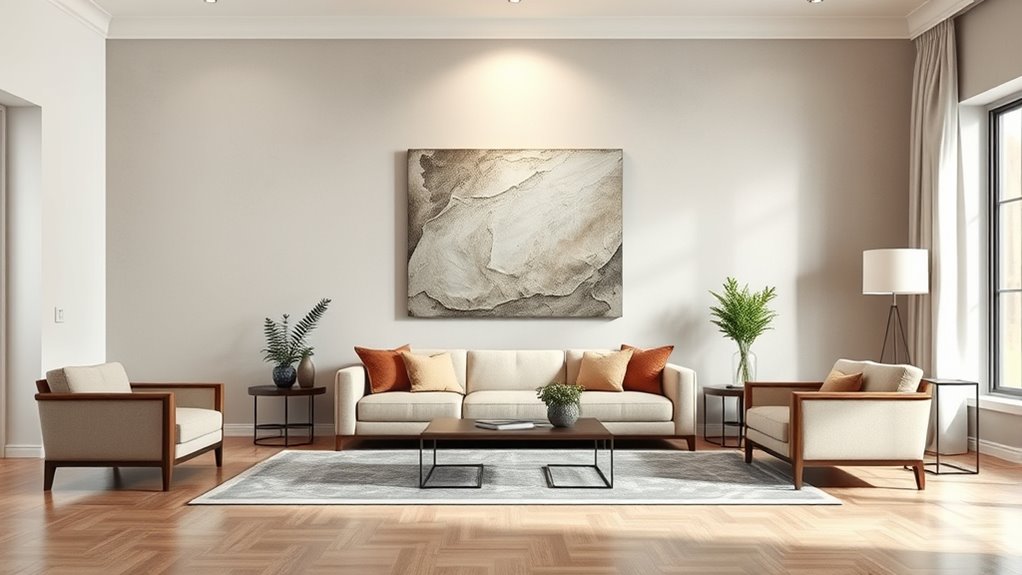
The 57-inch guideline for hanging art has roots in museum standards designed to guarantee ideal viewing. This standard emerged to optimize art placement, ensuring viewers can appreciate pieces at a comfortable eye level without straining or missing details. Museums aim for aesthetic harmony, creating a balanced environment where art enhances the space and invites engagement. The height of 57 inches aligns with the average eye level of viewers, making it easier for you to connect with artwork naturally. This consistent reference point helps maintain visual balance and harmony within a room, creating a cohesive and inviting atmosphere. While it’s a guideline, understanding its origins can help you make more informed decisions about art placement to achieve aesthetic harmony in your space. Additionally, considering art placement principles can further refine how you display artwork for optimal effect.
Why 57 Inches Works for Most Spaces
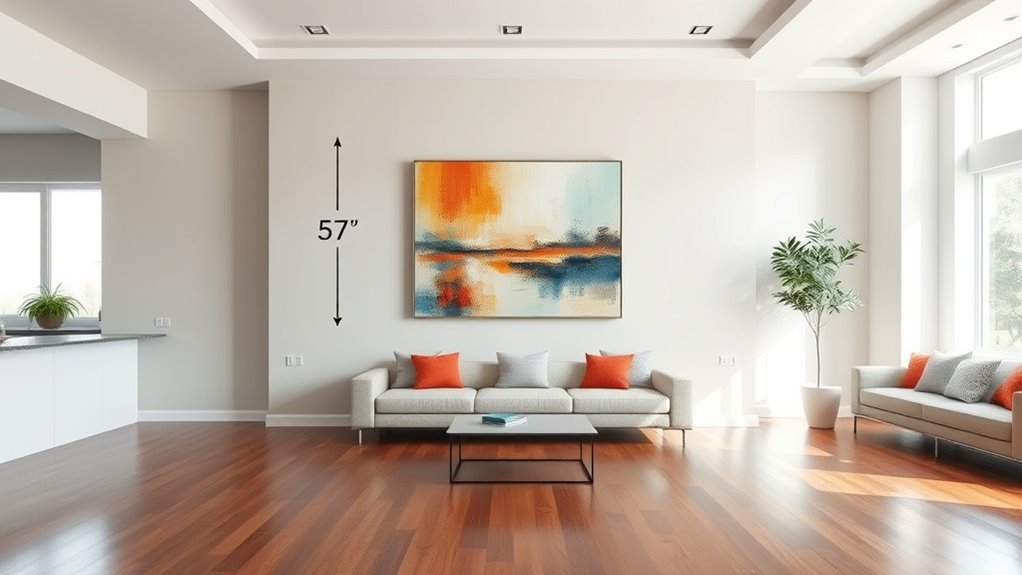
The 57-inch height aligns with standard eye level, making your art easily viewable without strain. It also creates a sense of visual balance in most rooms, preventing artwork from appearing lost or overwhelming. Plus, this height works well with typical ceiling heights, ensuring your display fits naturally in your space. Additionally, considering wall surface finishes can help determine the best placement for your artwork to enhance its appearance. Incorporating art positioning principles can further optimize how your art interacts with the overall room design. Being mindful of art lighting techniques can also significantly impact how your artwork is perceived at this height. Recognizing emotional support strategies can help homeowners and decorators handle the stress of decorating spaces, especially when making significant decisions like art placement.
Standard Eye Level
Since most people naturally focus on artwork around their eye level, setting art at approximately 57 inches from the floor guarantees it feels comfortable and balanced in a space. This standard eye level works well because it aligns with typical framing options, ensuring your art fits perfectly without awkward gaps or overlaps. It also simplifies lighting placement, allowing you to position lights for ideal illumination without creating glare or shadows. When hanging art at this height, you create a cohesive look that feels natural and inviting. Keep in mind that while 57 inches is a reliable guideline, adjustments might be necessary for larger pieces or high ceilings. Additionally, considering art placement guidelines and visual balance principles can help enhance the overall aesthetic and harmony of your display. Recognizing how perceived visual weight affects artwork placement can further refine your arrangement for optimal impact, especially when considering viewing distance to ensure comfort and clarity.
Visual Balance Achieved
Because 57 inches aligns with the average eye level, it creates a natural sense of balance in most rooms. This height promotes effective art placement, ensuring your artwork feels integrated within the space rather than overwhelming or underwhelming. When you hang art at this level, you enhance visual harmony, making the room more inviting and cohesive. It helps prevent awkward gaps or cluttered walls that disrupt the overall aesthetic. Additionally, this standard height works well across various room types, from living rooms to hallways. By sticking to the 57-inch rule, you ensure your art complements the environment and maintains a balanced focal point. It also aligns with principles of visual balance that are essential in interior design. This consistency makes your space feel thoughtfully curated and visually appealing. Properly art placement can also influence the perceived size and proportions of a room, making it seem more spacious and well-designed. Incorporating the proper height for hanging art can further enhance the overall aesthetic and harmony of your interior space. When considering different wall heights or art sizes, adjusting the hanging point slightly can help achieve the perfect visual harmony tailored to your specific space.
Room Height Compatibility
Hanging art at 57 inches often aligns perfectly with the typical room height, making it a versatile choice for most spaces. This height considers standard art framing and guarantees your artwork remains at eye level for comfortable viewing. It also adapts well to various wall textures, whether smooth or textured, providing a balanced visual impact. When you hang art this way, you create a cohesive look that suits different ceiling heights without feeling out of place. This rule simplifies decorating decisions and helps you avoid awkward gaps or overcrowded walls. Overall, 57 inches is a practical, reliable guide that works across many room types, making your art display both attractive and harmonious with your space’s proportions. Incorporating art placement strategies and unique and wicked planters into your decor can further enhance the overall aesthetic appeal. Additionally, considering wall proportions can help ensure your art complements the specific dimensions of your space.
How to Measure the Correct Height for Your Art
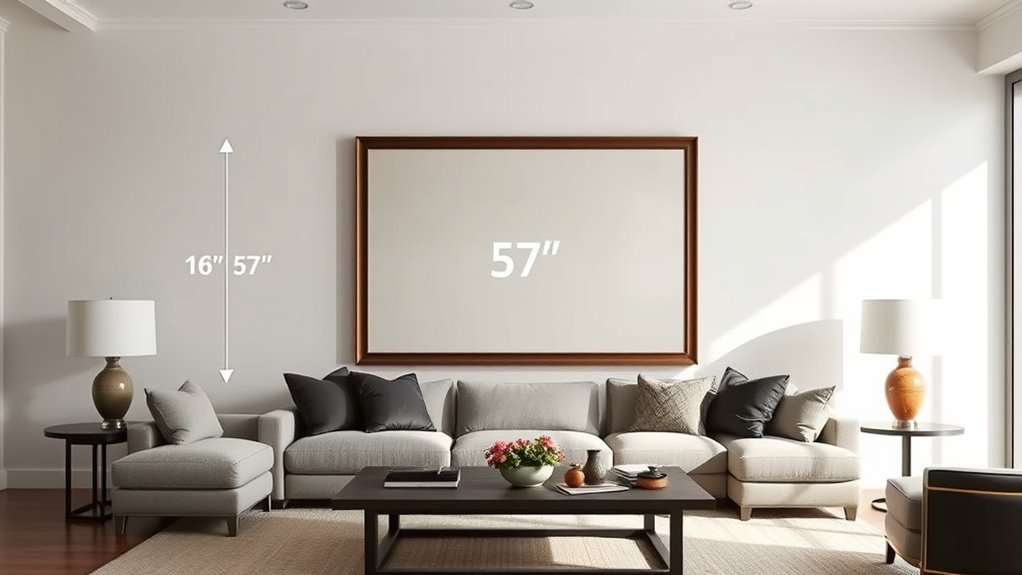
To guarantee your artwork looks perfect, start by identifying the ideal eye level for hanging. Measure from the floor to your eye level, typically around 57 inches, aligning with the 57‑inch rule. Use a tape measure for accuracy, and mark this height lightly on the wall. When hanging, consider color matching your art with the room’s palette to create harmony. Choose appropriate hanging hardware that supports the weight of your piece, ensuring stability. Keep in mind that larger artworks may need to be hung slightly higher or lower depending on furniture placement. Also, check the artwork’s center point and adjust accordingly. Proper measurement and attention to details like hanging hardware and color matching guarantee your art complements the space perfectly. Additionally, incorporating floral arrangements can enhance the overall aesthetic and ambiance of your room, creating a cohesive decorative style. For added visual appeal, consider the proportions of surrounding furniture to ensure your art maintains a balanced presence within the space. Paying attention to art placement and the lighting conditions can help you achieve a professional and polished look that elevates your interior design.
Adjusting the Rule for Different Artwork Sizes

When working with different artwork sizes, you’ll need to adjust the 57-inch rule to create a balanced display. Large pieces may require hanging higher or lower to stay proportionate, while small artworks benefit from being closer to eye level. By considering these size differences, you can develop effective eye-level alignment strategies that highlight each piece’s unique qualities. Incorporating space optimization techniques can further enhance how artwork is displayed in your space. Additionally, understanding visual balance principles ensures that your art arrangement feels cohesive and harmonious regardless of individual piece sizes, and selecting appropriate lighting can accentuate the artwork’s features effectively. Recognizing the importance of cultural significance in art placement can also influence how you present your artwork to reflect desired themes or traditions.
Large Artwork Adjustments
While the 57-inch rule works well for medium-sized artwork, larger pieces often require adjustments to guarantee they look balanced and visually appealing. For big artwork, consider lowering the hanging height slightly to avoid overwhelming the space. You might also need to optimize gallery lighting to highlight the piece without creating glare or shadows. Frame selection becomes vital; choose frames that complement the artwork’s scale and style, enhancing its presence. Additionally, measure the artwork’s center point relative to eye level, adjusting the hanging height accordingly. Keep in mind that larger pieces benefit from a more substantial wall anchoring to prevent tilting. These adjustments help create a cohesive display that draws attention and maintains harmony within your space.
Small Piece Considerations
Adjusting the 57-inch rule for small artworks guarantees they don’t get lost or seem out of place on your wall. Since tiny pieces can easily become overwhelmed or overlooked, consider lowering the art placement so that the center of the piece is closer to eye level, around 48 inches from the floor. This adjustment helps maintain balanced wall aesthetics and ensures your artwork remains a focal point without overpowering the space. For very small pieces, grouping multiple artworks or creating a gallery wall can also enhance visual impact. Remember, the key is to guarantee the artwork is proportional to the surrounding space, so it complements rather than competes with other decor. Tailoring your art placement ensures your small pieces stand out beautifully.
Eye-Level Alignment Strategies
Since artwork varies in size and impact, tailoring the eye-level placement guarantees each piece appears its best. Consider adjusting the height based on frame spacing to create visual harmony. Larger pieces may benefit from being hung slightly higher, ensuring they don’t get lost in the wall color or cluttered space. Conversely, smaller artwork should be positioned lower for better visibility and balance. Pay attention to wall color, as it influences how the art stands out; darker walls may require art to be hung slightly higher for contrast, while lighter walls can handle more flexible placement. Always measure the artwork’s dimensions and plan spacing accordingly to maintain cohesion and avoid overwhelming or underwhelming your wall display.
Considering Wall and Room Dimensions
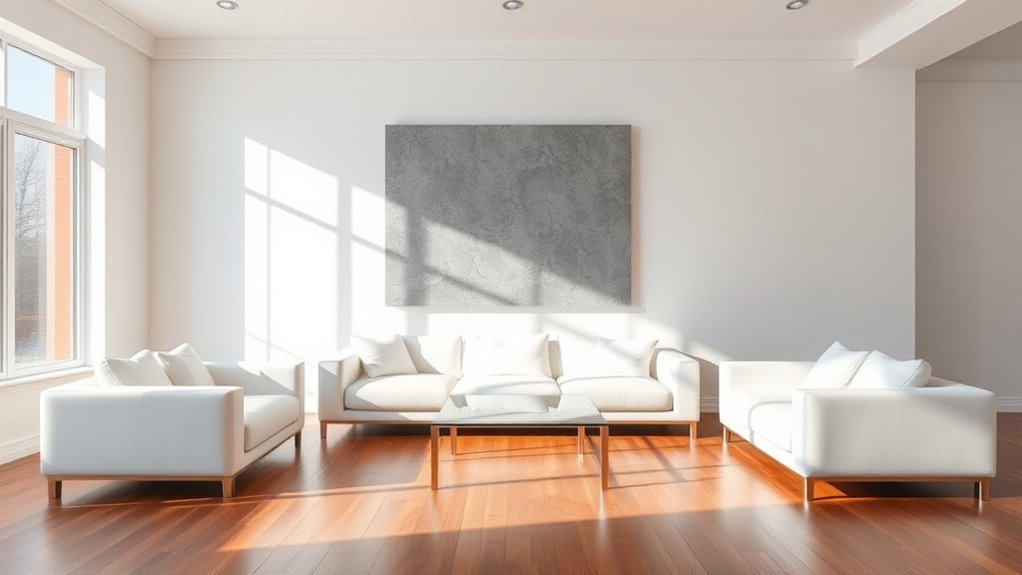
When choosing the right height for hanging art, you need to contemplate your wall and room dimensions carefully. The wall color can influence how your art stands out or blends in, so consider whether a lighter or darker background needs a different placement. Additionally, lighting effects play a vital role; direct lighting can highlight or cast shadows on your artwork, affecting its perceived height. Taller or shorter walls might require adjustments to the standard 57-inch rule to create visual balance. Measure the space carefully, accounting for ceiling height and any architectural features, so your art doesn’t seem out of place or overwhelmed. By understanding these dimensions, you’ll guarantee your artwork complements the room’s proportions and enhances its overall aesthetic.
The Role of Furniture Placement in Hanging Art
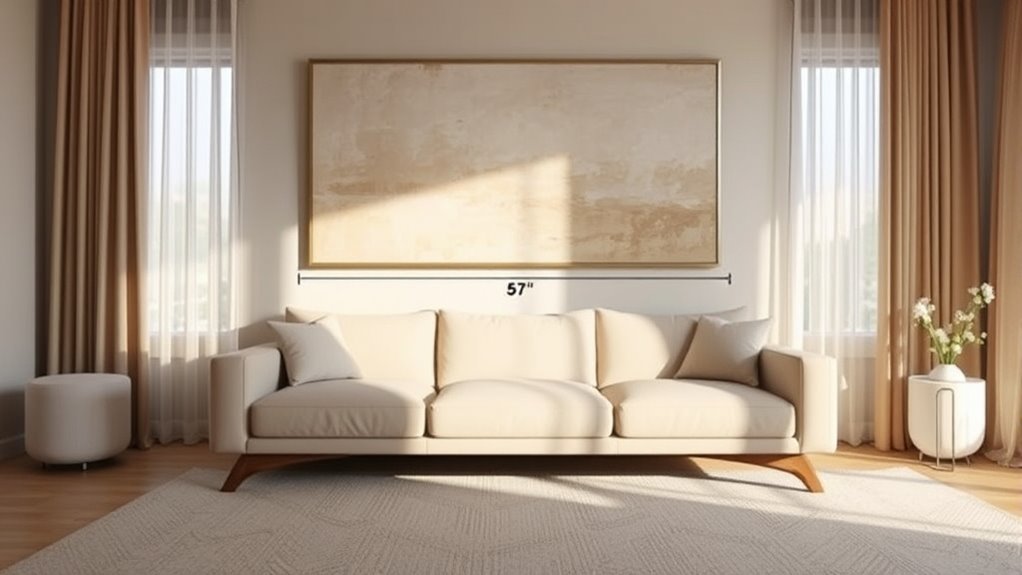
Furniture placement plays a crucial role in determining the ideal height for hanging your artwork. Your art arrangement should complement furniture pieces and emphasize the focal point of the room. When positioning art, consider how it interacts with sofas, tables, and other key furniture elements to create a balanced look. Properly aligned art enhances the room’s flow and draws attention to the focal point without overwhelming the space. Keep in mind that taller furniture pieces can shift the visual balance, requiring adjustments in hanging height. Aim to create a cohesive visual narrative where art and furniture work together seamlessly. Thoughtful placement ensures your artwork enhances the room’s aesthetic while maintaining harmony in the overall art arrangement.
Furniture placement influences artwork height, creating balance and harmony in your room’s visual narrative.
- How furniture height influences eye level and focal points
- The importance of aligning art with furniture edges
- Creating visual balance with artwork and furniture placement
- Adjusting art height based on furniture types and room layout
Tips for Hanging Multiple Pieces in a Gallery Wall
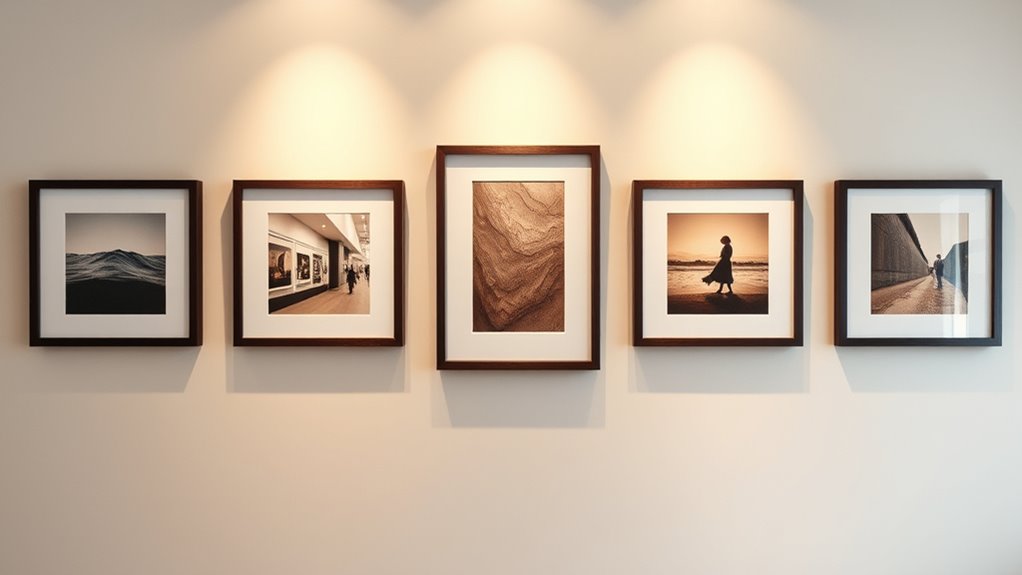
Creating a cohesive gallery wall starts with careful planning of your layout. Begin by arranging your pieces on the floor or using paper templates on the wall to experiment with spacing and alignment. Focus on a balanced gallery arrangement that mixes sizes and shapes to keep it visually interesting. Keep color coordination in mind; combining artwork with complementary or harmonious colors enhances unity. Aim for a central anchor piece, and then build outward, maintaining consistent spacing—usually 2 to 4 inches between frames. Use a level to ensure even hanging. Don’t forget to step back periodically to view your arrangement from a distance, adjusting as needed. Thoughtful planning and attention to color coordination will help your gallery wall look intentional and polished.
Common Mistakes to Avoid When Hanging Art
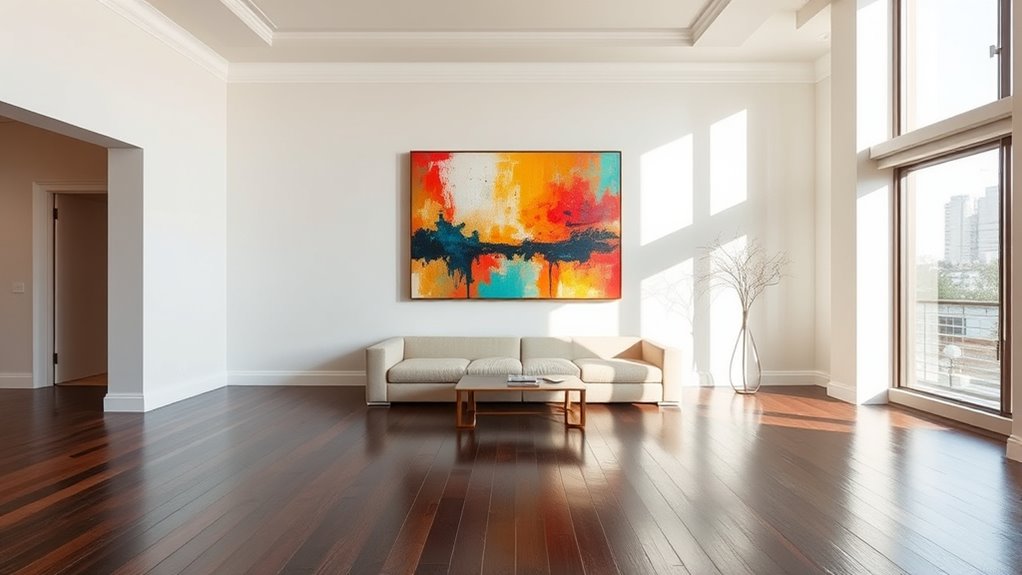
One common mistake people make when hanging art is positioning it too high on the wall. This can hinder your artistic expression and disrupt your interior design flow. To avoid this, guarantee your artwork is at eye level, around 57 inches from the floor, following the standard rule.
- Ignoring the scale of the artwork relative to the wall space
- Overcrowding or spacing pieces too far apart
- Using inconsistent hanging hardware that causes uneven placement
- Focusing solely on aesthetics without considering the room’s purpose
Alternative Strategies for Unique or Unusual Spaces
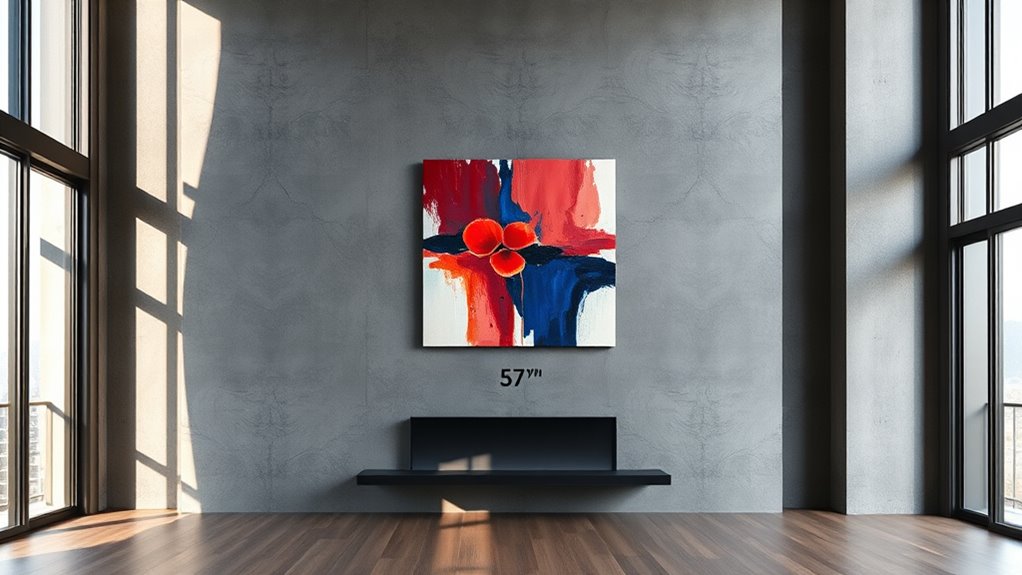
When working with unique or unconventional spaces, standard art hanging rules might not always apply. In these areas, consider customizing your approach with tailored framing techniques to enhance the artwork’s impact. Effective gallery lighting can highlight focal points and add depth, especially in irregularly shaped or high-ceilinged rooms. Instead of relying solely on the 57-inch rule, experiment with hanging art at varying heights to suit the space’s proportions and architectural features. For uneven walls, use creative arrangements like asymmetrical groupings or floating displays. These strategies allow you to adapt to challenging spaces while maintaining visual harmony. Remember, the goal is to create a balanced, engaging display that complements the environment and showcases the art’s unique qualities.
Frequently Asked Questions
Can the 57-Inch Rule Be Applied to Ceiling-Mounted or Suspended Artwork?
You can apply the 57-inch rule to ceiling-mounted or suspended artwork, but you need to take into account lighting and framing techniques. Make certain the artwork hangs at eye level, factoring in lighting considerations that highlight its details without causing glare. Use appropriate framing techniques to support the suspended piece and maintain visual balance. Adjust the height slightly if lighting or framing needs demand, keeping the viewer’s comfort and the art’s display in mind.
How Does Artwork Height Influence the Viewer’s Perception and Experience?
Artwork height is like the rhythm in a song—setting the tone for your experience. When you hang art at eye level, it creates visual harmony, making it easier for viewers to engage deeply. If the piece is too high or low, it can disrupt the flow, reducing engagement and making the art less impactful. Proper height guarantees your audience perceives and connects with the work effortlessly.
Is the 57-Inch Rule Suitable for Outdoor or Weather-Exposed Art Installations?
The 57-inch rule isn’t ideal for outdoor or weather-exposed art installations due to weather considerations and outdoor durability. You should adjust hanging height, considering exposure to wind, rain, and sun, which can impact the artwork’s longevity. Use weather-resistant materials and make certain of proper mounting to protect your art. Hanging slightly higher or lower than the standard height helps prevent damage and ensures your outdoor art remains visible and intact over time.
How Do Different Ceiling Heights Affect the Optimal Hanging Height?
You should adjust art placement based on ceiling heights to achieve ideal gallery design. For higher ceilings, hang art slightly higher than the 57-inch rule, giving it space to breathe and maintain balance. Conversely, with lower ceilings, lower the artwork to prevent a cramped feeling. Always consider the overall room proportions to create a cohesive display, ensuring your art enhances the space and guides viewers’ eyes comfortably.
Can the 57-Inch Guideline Be Adjusted for Art in Commercial or Public Spaces?
Imagine walking into a bustling gallery display, where art installation heights draw your eyes effortlessly. You can modify the 57-inch guideline for commercial or public spaces—consider taller ceilings or crowd flow. In such settings, hang art at eye level for viewers, typically around 60 inches, to guarantee visibility. Tailor your display height to create an inviting atmosphere, allowing your artwork to captivate without overwhelming the space.
Conclusion
Now that you know the ins and outs of the 57-inch rule, you’re ready to hang your art like a pro. Remember, it’s not always a one-size-fits-all situation—trust your eye and make adjustments as needed. After all, you don’t want your artwork to be the odd man out. With a little practice, you’ll find the perfect height that turns any wall into a showstopper. Happy hanging!
